Summary
It has shown that several characteristics of high-producing industrial strains of Penicillium chrysogenum tend to segregate in the course of cultivation (slant-to-slant transfer). Segregation includes a decrease in the yield of penicillin, mean conidial size, mean size of the nuclei, and an increase in the proportion of morphologically wild-type colonies. These lower-producing segregants also have a higher sensitivity against ultraviolet radiation and, as shown by cytofluorometric methods, a lower DNA content in the condia, a decrease in phosphate uptkae and in the activity of extracellular alkaline phosphatases compared to high-producing strains. Obviously, during mutagenesis/selection programmes ploidy mutants have been selected, which entails an increase in the number of genes coding enzymes responsible for penicillin biosynthesis. In the absence of selection pressure these high-producing strains segregate to lower-producing strains by chromosome losses in the course of slant-to-slant transfers.
Similar content being viewed by others
References
Alichanjan SI (1972) Grundlagen der Genetik und Züchtung industriell genutzter Mikroorganismen. Fischer, Jena
Ball C (1973) The genetics of Penicillium chrysogenum. Prog Ind Microbiol 12:47–72
Barredo JL, Diez B, Alvarez E, Martin JF (1989) Large amplification of a 35-kb DNA fragment carrying two penicillin biosynthetic genes in high penicillin producing strains of Penicillium chrysogenum. Curr Genet 16:453–459
Burnett JH (1975) Industrial applications of fungal genetics. In: Burnett JH (ed) Mycogenetics. Wiley, London, p 235
Chen PS, Toribara TY, Warner H (1956) Microdetermination of phosphorus. Anal Chem 28:1756–1758
Elander RP (1967) Enhanced penicillin biosynthesis in mutant and recombinant strains of Penicillium chrysogenum. In: Stubbe H (ed) Induced mutations and their utilization. Akademie-Verlag, Berlin, p 403
Horn M, Bormann E-J, Harnisch M (1984) Ein statistisches Verfahren zur Ermittlung der Leistungskorrelation antibioticabildender Mikroorganismen im Labor- und Technikumsmass-stab. Z Allg Mikrobiol 24:443–449
Kurylowicz W, Kurzatkowski W, Woznicka W, Polowniak-Pracka H, Paszkiewicz A, Luba J, Piorunowski J (1980) Atlas of ultrastracture of Penicillium chrysogenum in course of biosynthesis of penicillin. Chemia Publishing Office, Warsaw
Lein J (1986) The Panlabs penicillin strain improvement program. In: Vanek Z, Hostalek Z (eds) Overproduction of microbial metabolites: strain improvement and process control strategies. Butterworths, Boston, p 105
Queener S, Swartz R (1979) Penicillins: biosynthetic and semisynthetic. In: Rose AH (ed) Secondary products of metabolism (Economic microbiology, vol. 3). Academic Press, London, p 35
Risch S (1991) Die Bedeutung von Ploidiemutationen und parasexuellen Vorgängen für die Stammentwicklung bei Pilzen. Dissertation, Martin-Luther-Universität, Halle
Risch S, Künkel W (1987) Parasexuality and strain development. In: Weber H (ed) Abstract of the XIIth International Specialized Symposium on Yeasts — Genetics of Non-conventional Yeasts. 13–19 November 1987. Weimar, ZIMET, Jena, p 80
Schmidt G, Bartsch G, Lanmont M-G, Herman T, Liss M (1963) Acid phosphatase of baker's yeast: an enzyme of the external cell surface. Biochemistry 2:126–131
Smith DJ, Bull JH, Edwards J, Turner G (1989) Amplification of the isopenicillin N synthetase gene in a strain of Penicillium chrysogenum producing high levels of penicillin. Mol Gen Genet 216:492–497
Uden N van (1951) Eine einfache Methode zum Studium der Pilzmorphologie im allgemeinen und der vegetativen Anastomosen im besonderen. Arch Dermatol Syphilis 193:468–484
Author information
Authors and Affiliations
Additional information
Offprint requests to: W. Künkel
Rights and permissions
About this article
Cite this article
Künkel, W., Berger, D., Risch, S. et al. Genetic instability of industrial strains of Penicillium chrysogenum . Appl Microbiol Biotechnol 36, 499–502 (1992). https://doi.org/10.1007/BF00170191
Received:
Accepted:
Issue Date:
DOI: https://doi.org/10.1007/BF00170191
